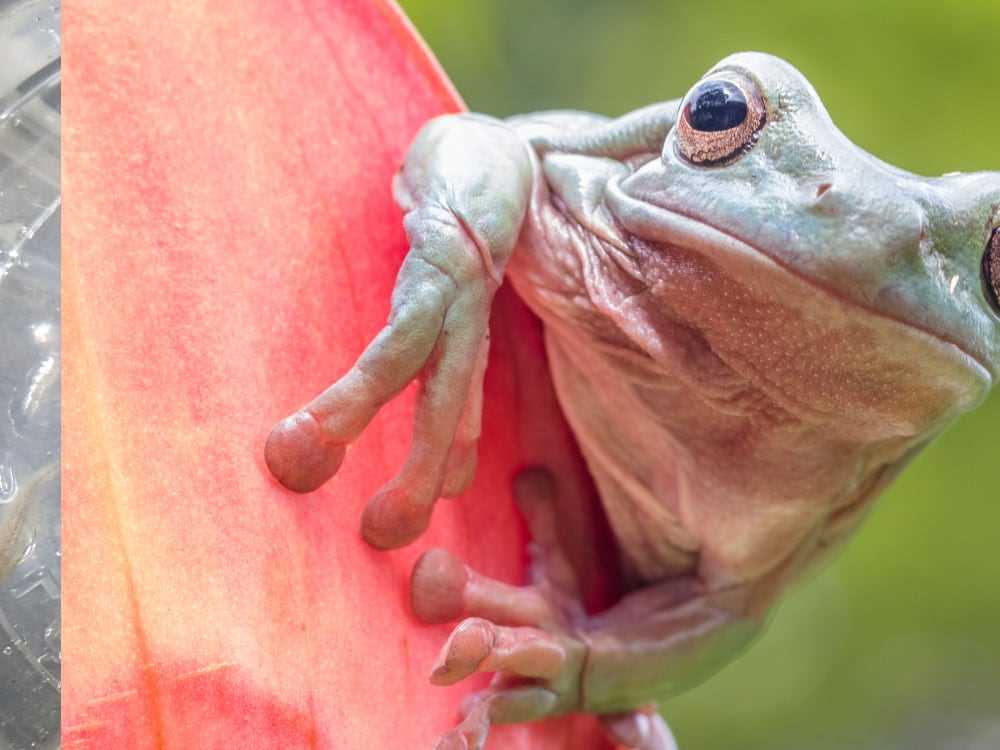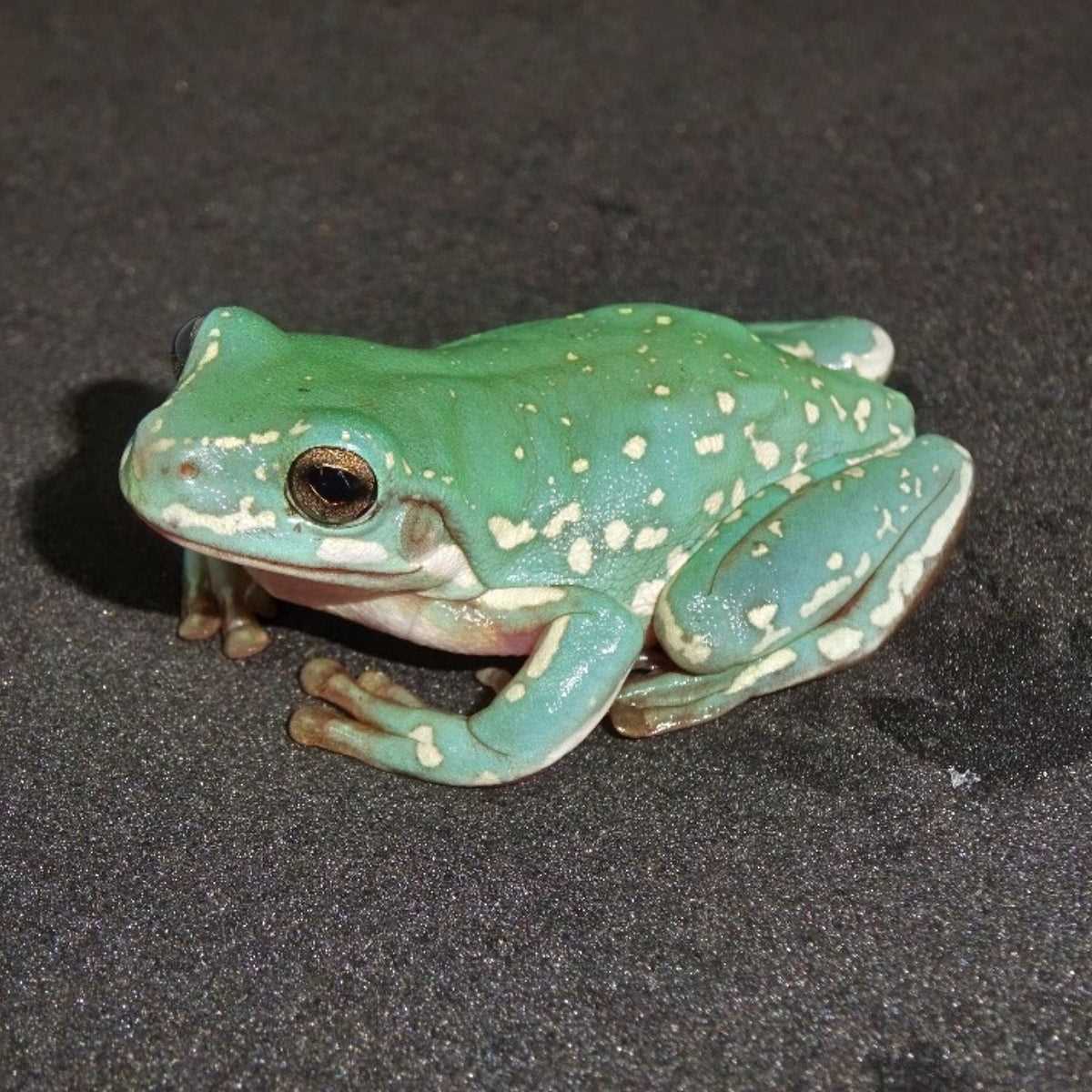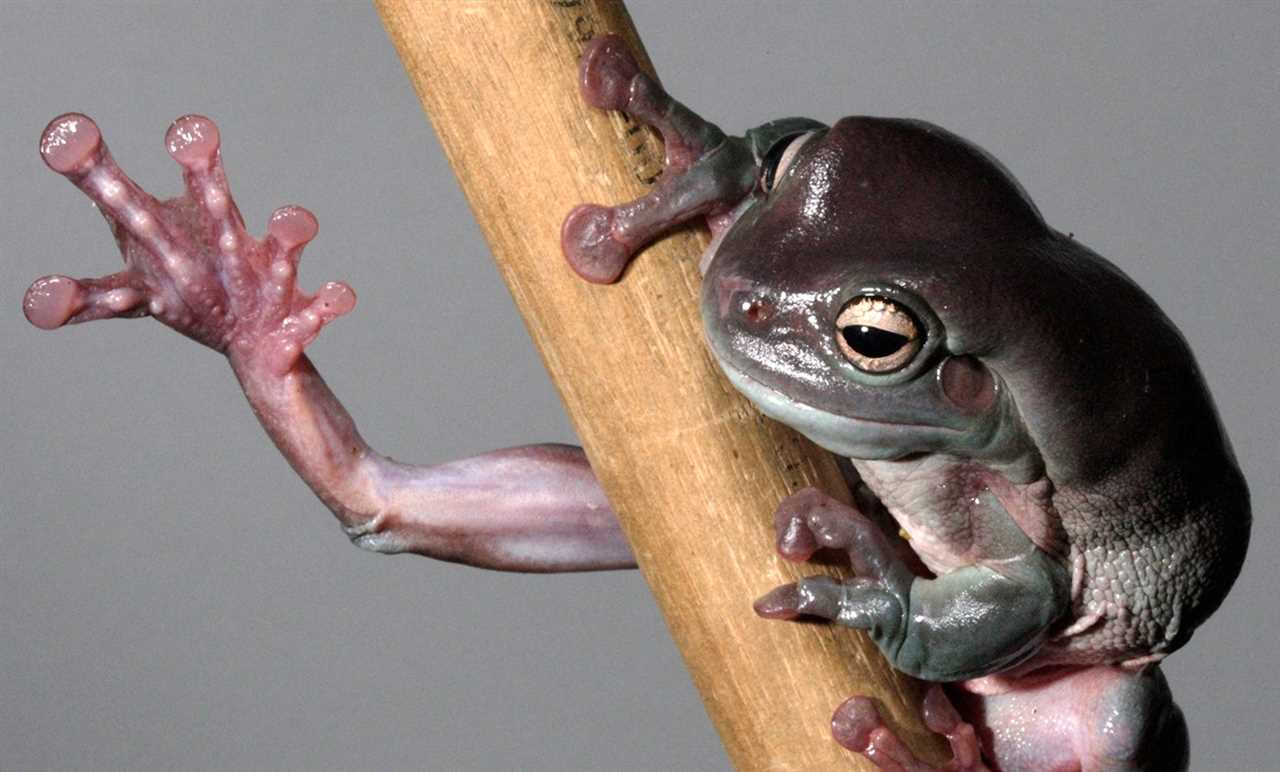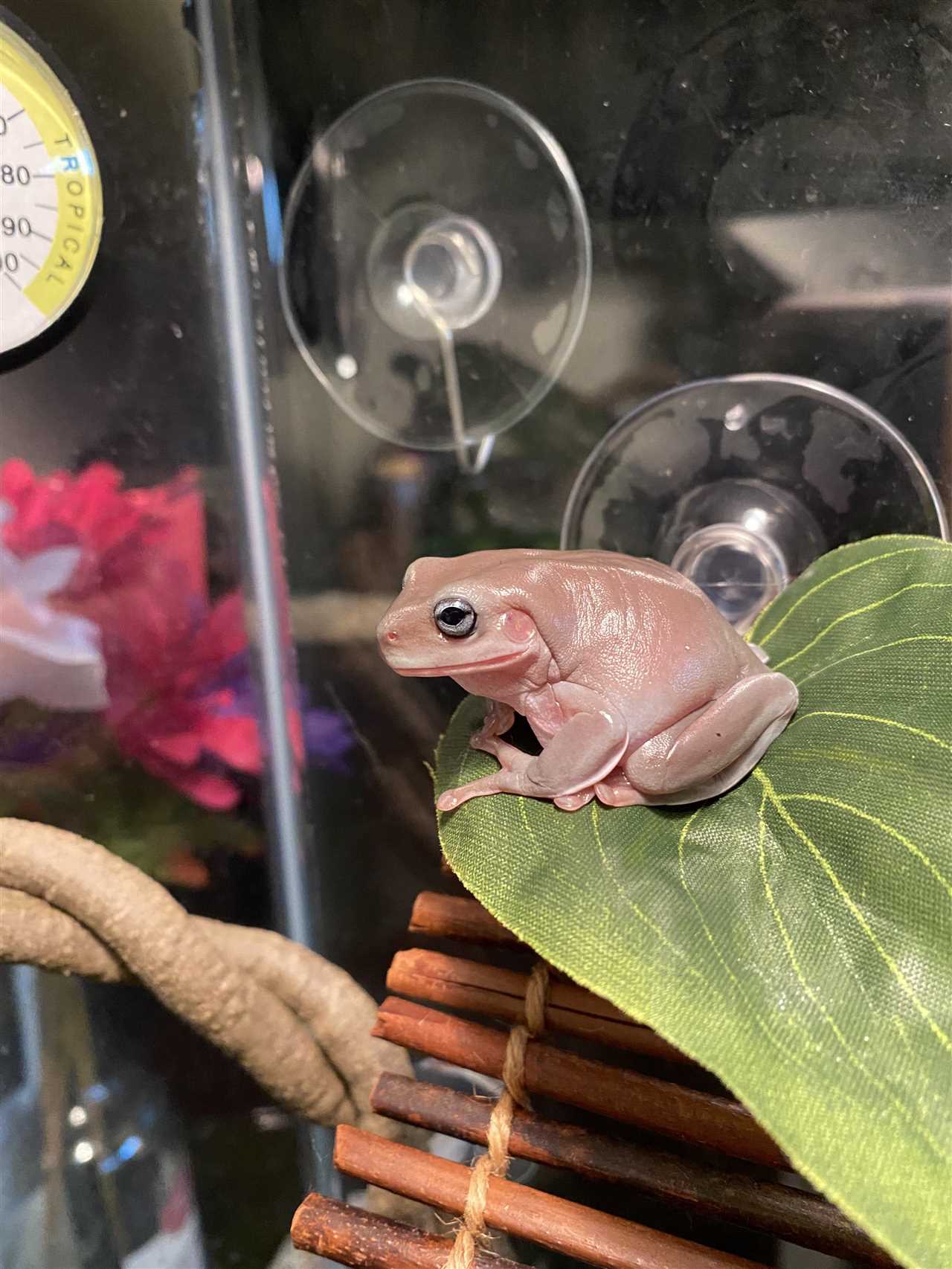
The world of morphs in the frog kingdom is a captivating one, filled with extraordinary creatures that leave us in awe. Among these fascinating beings, the white tree frog morphs stand out for their unique and stunning appearances. These enchanting frogs come in a variety of color patterns and variations, making them a true wonder of nature.
One of the most remarkable features of white tree frog morphs is the range of colors they can display. From pure white to shades of yellow, orange, and green, these frogs showcase a mesmerizing palette that can captivate any observer. Their ability to change color also adds to their allure, allowing them to blend with their environment and adapt to different situations.
But it is not just their colors that make white tree frog morphs special. Their physical characteristics also contribute to their charm. With their large, expressive eyes and slender bodies, these frogs exude an elegant and graceful presence. Their smooth skin and well-defined limbs further enhance their visual appeal, making them a true delight to behold.
The Amazing Variety of White Tree Frog Morphs
Morphs in white tree frogs refer to the different color combinations, patterns, and variations that exist within the species. These variations occur due to genetic mutations, which can result in unique and visually striking appearances.
A Diverse Palette of Colors
One of the most fascinating aspects of white tree frog morphs is the diverse palette of colors they exhibit. While the base color of these frogs is typically a shade of green or blue, morphs can display various shades and intensities of these colors.
Some morphs exhibit vibrant and eye-catching colors, such as bright blue or vivid green, while others may have more muted and pastel tones. Additionally, white tree frog morphs can also feature color combinations, with individuals displaying multiple colors or even color gradients.
A Plethora of Patterns
In addition to their stunning array of colors, white tree frog morphs also display a plethora of patterns. These patterns can include spots, stripes, blotches, and marbled or mottled patterns. Each individual frog can have a unique combination of patterns, making them truly one-of-a-kind.
The Influence of Genetics
The genetics behind white tree frog morphs are complex and not fully understood. However, it is believed that these morphological variations are influenced by a combination of genetic factors, such as gene mutations and inheritance patterns.
Herpetologists and breeders have been studying the genetics of white tree frog morphs in order to better understand how these variations occur and how they can be reproduced through selective breeding. This research has led to the development of specific breeding programs aimed at producing certain morphs.
Popularity in the Pet Trade
White tree frog morphs have gained popularity in the pet trade due to their striking appearances and relatively easy care requirements. These frogs are often sought after by reptile enthusiasts and collectors who appreciate their unique beauty and the challenge of breeding specific morphs.
In recent years, there has been an increase in the availability of different morphs in the pet trade, allowing more people to enjoy the captivating world of white tree frog varieties.
Conclusion
The amazing variety of white tree frog morphs showcases the wonders of nature’s diversity. With their mesmerizing colors and patterns, these frogs continue to captivate and intrigue reptile enthusiasts around the world. Whether you are a hobbyist or a scientist, exploring the world of white tree frog morphs is sure to be an adventure filled with awe and wonder.
The Genetics behind White Tree Frog Morphs
Genes and Coloration:
One of the main genetic factors that influence the coloration of white tree frog morphs is the presence or absence of certain pigment genes. These genes determine the production and distribution of pigments responsible for the frog’s colors. Different combinations of these genes can result in variations such as green, blue, or albino morphs.
Dominant and Recessive Genes:
Mutations and New Morphs:
In addition to the normal genetic variations, white tree frog morphs can also arise from genetic mutations. These mutations can occur spontaneously or be the result of selective breeding. In some cases, these mutations can lead to the development of entirely new morphs, further expanding the diversity of white tree frog appearances.
The Role of Genetics in Breeding:
Breeding White Tree Frog Morphs: A Guide for Enthusiasts
Choosing Breeding Pairs
Creating the Right Environment
Before introducing the breeding pairs, it’s essential to set up a suitable breeding environment. This should mimic the frogs’ natural habitat and include a spacious enclosure with plenty of plants, hiding spots, and a water source for the frogs to lay their eggs. Maintaining the right temperature and humidity levels is also crucial for successful breeding.
Triggering Breeding Behavior
White tree frog morphs require specific conditions to trigger their breeding behavior. Mimicking the rainy season in their native habitat can be achieved by gradually increasing the humidity and decreasing the daylight hours. This can be done using a misting system and adjusting the lighting schedule in the enclosure.
Egg Laying and Care
Handling the Tadpoles
Raising the Froglets
Once the froglets have developed hind legs and absorbed their tails, they can be transferred to a terrestrial environment. Provide them with a smaller, well-ventilated enclosure, suitable substrate, and hiding spots. Feed them a diet of small insects, such as fruit flies or pinhead crickets, and ensure they have access to clean water at all times.
Continued Care and Observation
The Joy of Breeding White Tree Frog Morphs
The Popular White Tree Frog Morphs in the Pet Trade

1. Albino White Tree Frog Morph
One of the most sought-after morphs is the albino white tree frog. These frogs lack the pigmentation that gives their skin a green or brown color, resulting in a beautiful white appearance. Albino white tree frogs have translucent skin that allows you to see their internal organs, adding to their unique charm.
2. Patternless White Tree Frog Morph
3. High White White Tree Frog Morph

The high white white tree frog is a morph that displays a high concentration of white coloration on its body. These frogs have minimal green or brown pigmentation, making them predominantly white. Their striking appearance is often compared to a marble sculpture, making them a captivating addition to any collection.
4. Blue and White White Tree Frog Morph
A unique morph that stands out among the rest is the blue and white white tree frog. These frogs have vibrant blue patches on their skin, complemented by a white or cream-colored background. The striking contrast between the blue and white colors makes them truly eye-catching and highly desirable among enthusiasts.
The Exotic White Tree Frog Morphs You’ve Never Heard Of
While the popular white tree frog morphs in the pet trade are well-known, there are many exotic varieties that you may have never heard of. These rare and fascinating morphs are highly sought after by collectors and enthusiasts alike.
- The Blue-Spotted Tree Frog: This morph features a stunning blue coloration with vibrant spots covering its body. The contrast between the blue and white creates a mesmerizing pattern that is truly one-of-a-kind.
- The Leucistic Tree Frog: Leucistic morphs lack the pigmentation that gives the common white tree frog its signature color. Instead, they have a pale, almost translucent appearance that gives them an ethereal and otherworldly beauty.
- The Diamondback Tree Frog: This morph features a unique diamond-shaped pattern on its back, resembling the scales of a snake. The contrast between the white body and the dark diamond patterns creates a visually stunning effect.
- The Pumpkin Tree Frog: Named for its rich orange color, this morph is reminiscent of a ripe pumpkin. Its bold and vibrant hue makes it stand out among other tree frog morphs.
These are just a few examples of the many exotic white tree frog morphs that exist. Each one is a testament to the incredible diversity and beauty found in nature. Whether you are a collector, enthusiast, or just fascinated by these fascinating creatures, exploring the world of white tree frog morphs is sure to be an exciting adventure.
The Science of Coloration in White Tree Frog Morphs
One of the main factors influencing the coloration of white tree frog morphs is genetics. Different genetic variations can result in a wide range of colors, patterns, and markings. These variations are inherited from the parents and can be passed down to future generations.
Researchers have identified specific genes that play a role in determining the coloration of white tree frog morphs. These genes can control the production of pigments, such as melanin, which gives frogs their dark colors, or pteridine, which gives frogs their bright yellow and orange colors. The interaction between these genes and their expression patterns can lead to the creation of unique color combinations.
Environmental factors also play a part in shaping the coloration of white tree frog morphs. The amount of light, temperature, and humidity in their habitat can affect the intensity and brightness of their colors. For example, frogs exposed to higher levels of light may develop more vibrant colors, while those kept in cooler temperatures may have darker hues.
Additionally, the diet of white tree frogs can influence their coloration. Consuming certain foods rich in pigments can enhance or modify the colors of their skin. For instance, a diet high in carotenoids can result in frogs with more intense red or orange coloration.
The Role of Environment in Shaping White Tree Frog Morphs
For example, white tree frogs that inhabit lush green areas with dense foliage may exhibit morphs with green or brown tones. Their skin’s pigmentation adapts to the greenery, helping them stay hidden from predators. On the other hand, white tree frogs living in drier, more arid regions may have lighter, pale morphs, enabling them to blend in with their sandy surroundings.
Temperature and light also play a significant role in shaping white tree frog morphs. These frogs are ectothermic, meaning that their body temperature is regulated by the temperature of their surroundings. Warmer environments tend to produce darker, more vibrant morphs, while cooler temperatures can result in lighter, duller colors.
The availability of water sources can also affect the appearance of white tree frog morphs. Frogs that live near bodies of water, such as rivers or ponds, may have more vibrant and saturated colors compared to those living in drier areas. The water’s proximity provides a more favorable environment for algae and other food sources, which can enhance the frog’s pigmentation.
Rare White Tree Frog Morphs: Their Origins and Conservation
Efforts are being made to conserve the natural habitats of white tree frogs and educate the public about their importance. Conservation organizations work to protect the areas where these frogs live and advocate for their conservation. Additionally, breeding programs and captive breeding efforts help ensure the survival of these rare morphs in captivity.
The White Tree Frog Morphs: A Fascinating Species in Their Natural Habitat
White tree frog morphs are typically found in the tropical and subtropical regions of Australia. They can be seen in various habitats, including rainforests, woodlands, and suburban areas. These frogs have excellent climbing abilities and are often found perched on trees or shrubs.
One of the most fascinating aspects of white tree frog morphs is their coloration. While their base color is usually green, they can change their skin color to better match their surroundings. This adaptive ability not only helps them camouflage from predators but also allows them to regulate their body temperature.
Adaptive Camouflage
Their ability to change color is controlled by specialized cells in their skin called chromatophores. These cells contain pigments that can be expanded or contracted, allowing the frog to change its appearance. The color change is triggered by external factors such as light, temperature, and humidity.
White tree frog morphs are masters of disguise, and their adaptive camouflage plays a vital role in their survival. They can blend in with various backgrounds, including leaves, branches, and even rocks. This ability not only helps them evade predators but also aids in their hunting techniques.
The Relationship with Their Natural Habitat
| Key Points: |
|---|
| – White tree frog morphs are found in the tropical and subtropical regions of Australia. |
| – Their natural habitat consists of water bodies and vegetation, providing them with breeding and feeding grounds. |
| – Preservation of their natural habitat is essential for their long-term survival. |
The White Tree Frog Morphs: A Symbol of Australia’s Biodiversity
Australia is known for its diverse and unique wildlife, and the white tree frog morphs are a perfect example of this. These fascinating creatures are a symbol of Australia’s biodiversity and play an important role in the ecosystem.
Adaptability and Survival
One of the reasons why white tree frog morphs are so interesting is their ability to adapt to different environments. They have the unique ability to change their coloration to match their surroundings, making them excellent camouflagers.
This adaptation helps them hide from predators and increases their chances of survival. It also allows them to blend in with their surroundings when hunting for food, which primarily consists of insects, spiders, and other small invertebrates.
White tree frog morphs are also known for their excellent climbing abilities. They have specially adapted toe pads that allow them to grip onto vertical surfaces, including trees, walls, and even windows. This adaptation makes them well-suited for their arboreal lifestyle.
Conservation and Biodiversity
The white tree frog morphs play an important role in Australia’s biodiversity. They are considered an indicator species, meaning that their presence or absence can indicate the health of an ecosystem. Their ability to adapt and survive in various habitats makes them an important part of the food chain.
However, like many other amphibians, white tree frog morphs face various threats to their population. Habitat loss, pollution, and the introduction of non-native predators are all factors contributing to their decline. Climate change is also a concern, as it can lead to the alteration of their habitat and breeding patterns.
Efforts are being made to conserve and protect the white tree frog morphs and their natural habitat. These efforts include habitat restoration, captive breeding programs, and public education about the importance of preserving Australia’s biodiversity.
Conclusion
The white tree frog morphs are not just fascinating creatures, but also symbols of Australia’s rich biodiversity. Their ability to adapt, survive, and thrive in different environments is a testament to the resilience of nature.
However, their continued existence is threatened by various factors, highlighting the importance of conservation and preservation efforts. By working together to protect these unique and beautiful creatures, we can ensure that future generations can continue to enjoy the wonders of Australia’s wildlife.
Tips for Caring for White Tree Frog Morphs as Pets
1. Create a suitable habitat
White tree frog morphs need a spacious enclosure with plenty of climbing space. A terrarium with vertical branches, plants, and hiding spots will provide them with an environment that closely resembles their natural habitat.
2. Maintain optimal temperature and humidity

3. Provide a varied diet
These frogs are insectivores, and their diet should consist primarily of live insects such as crickets, roaches, and mealworms. Dusting their food with calcium and vitamin supplements is essential to ensure they receive proper nutrition.
4. Offer clean water
White tree frog morphs need access to clean, chlorine-free water for hydration and soaking. Providing a shallow water dish or misting the enclosure regularly will help maintain their hydration levels.
5. Maintain proper hygiene
Cleanliness is crucial for the health of your white tree frog morphs. Regularly clean their enclosure, removing any waste or uneaten food. Additionally, make sure to wash your hands before and after handling them to prevent the spread of bacteria.
6. Provide proper lighting
White tree frog morphs require a light cycle that mimics natural daylight. A full-spectrum UVB light should be provided for 12-14 hours a day to ensure they receive the necessary vitamin D for calcium absorption.
7. Monitor their health
8. Avoid overhandling
| White Tree Frog Morphs Care Summary: |
|---|
| – Create a suitable habitat with climbing spaces and hiding spots. |
| – Maintain optimal temperature (75-85 degrees Fahrenheit) and humidity (50-70%). |
| – Provide a varied diet of live insects dusted with calcium and vitamin supplements. |
| – Offer clean, chlorine-free water for hydration. |
| – Regularly clean the enclosure and practice good hygiene. |
| – Provide proper lighting with a full-spectrum UVB light. |
| – Monitor their health for any signs of illness or distress. |
| – Minimize stress by avoiding excessive handling. |
By following these tips, you can provide the best care for your white tree frog morphs and enjoy their unique beauty and charm as pets.
The White Tree Frog Morphs: A Perfect Addition to Your Reptile Collection
If you are a reptile enthusiast and looking to add a unique and beautiful creature to your collection, white tree frog morphs are a perfect choice. These stunning amphibians, with their diverse colors and patterns, can add a touch of elegance and beauty to any reptile habitat.
One of the most appealing aspects of white tree frog morphs is their wide range of colors and patterns. These morphs can come in various shades of white, cream, and gray, with patterns ranging from spots to stripes. Some morphs even have vibrant blue or green coloration, adding a stunning pop of color to their appearance.
Creating a Suitable Habitat
When keeping white tree frog morphs as pets, it is essential to provide them with a suitable habitat that mimics their natural environment. A spacious terrarium with plenty of climbing branches and hiding spots is crucial for their well-being. It is also important to maintain a temperature and humidity level that resembles their native habitat.
White tree frog morphs are nocturnal creatures, so providing low levels of ambient light during the day and a soft, warm light at night will help promote their natural behavior and health. Additionally, a shallow water dish should be included in their enclosure to allow them to soak and hydrate as needed.
Diet and Feeding
Handling and Care
Regular monitoring of their habitat, including temperature, humidity, and cleanliness, is crucial for their well-being. Any changes in behavior, appetite, or appearance should be closely monitored and addressed promptly.
The Beauty of White Tree Frog Morphs: Capturing Them in Photography
White tree frog morphs are not only fascinating creatures in their own right, but they also make perfect subjects for photography enthusiasts. With their unique colors and patterns, these morphs offer a wealth of opportunities for capturing stunning images.
Lighting is key when photographing white tree frog morphs. These frogs have beautiful coloration, which can be accentuated by proper lighting. Natural, diffused light is ideal for showcasing their vibrant patterns. Avoid using direct flash, as it can create harsh shadows and wash out the colors of the frogs.
Patience is paramount when photographing white tree frog morphs. These frogs can be elusive and may require some waiting to capture the perfect shot. Take your time and observe their behavior to anticipate their movements. Remember, it’s worth the effort to capture these beautiful creatures in their natural element.
Post-processing can also enhance the beauty of your white tree frog morph photos. Adjusting the contrast and saturation can help bring out the vibrant colors. Experiment with different filters or editing techniques to create a unique and visually striking image.
Sharing your photos of white tree frog morphs can help raise awareness about these incredible creatures and their conservation needs. You can contribute to scientific research and education initiatives by participating in citizen science projects or sharing your images with wildlife organizations.
The Future of White Tree Frog Morphs: Potential Discoveries
Another area of interest is the development of specific traits and characteristics. By selectively breeding white tree frogs with desired traits, such as larger size or unique patterns, breeders can work towards creating new and distinct morphs. These efforts could result in white tree frogs that stand out even more in the pet trade, offering enthusiasts an even greater variety to choose from.
The future of white tree frog morphs also holds potential for advancements in captive care and husbandry. As more is learned about their specific needs and requirements, keepers can provide even better care for these unique frogs. This includes providing appropriate housing, diet, and environmental conditions, ensuring their health and well-being.
Lastly, the future of white tree frog morphs is also tied to the education and awareness surrounding these creatures. By sharing knowledge about their biology, behavior, and conservation status, more people can appreciate the beauty and importance of these frogs. This increased awareness can lead to greater efforts to protect their habitats and ensure their survival in the wild.

I’m Lena Adams—a product of an unconventional upbringing in the African wilderness. My father, a daring explorer of African wildlife, sparked my fascination with reptiles, a passion that intertwined with the tragic loss of my mother during an expedition, leaving an indelible mark on my life. Driven to understand the creatures that captivated my parents, I embarked on my journey, sharing insights about reptiles, frogs, and lizards on my website. Through my explorations and conservation efforts, I honour my family’s legacy while seeking connections—to the creatures, nature, and the mother whose presence I yearn to understand.
